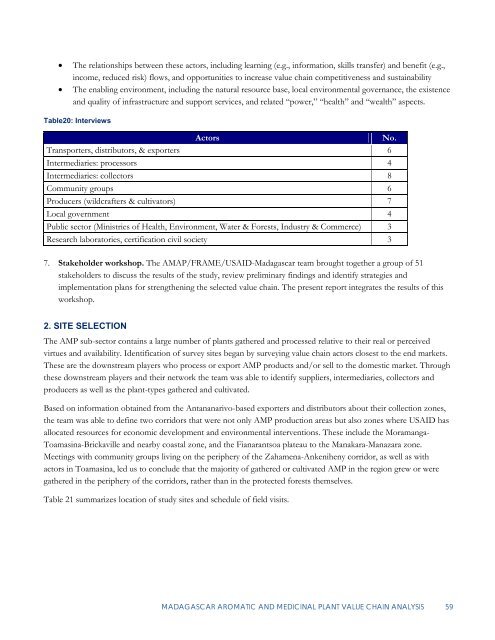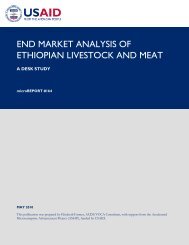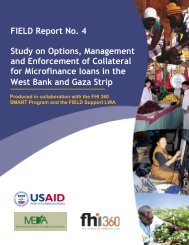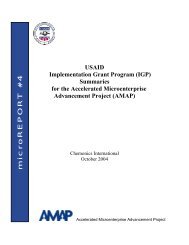Madagascar Aromatic and Medicinal Plants Value - Microlinks
Madagascar Aromatic and Medicinal Plants Value - Microlinks
Madagascar Aromatic and Medicinal Plants Value - Microlinks
You also want an ePaper? Increase the reach of your titles
YUMPU automatically turns print PDFs into web optimized ePapers that Google loves.
• The relationships between these actors, including learning (e.g., information, skills transfer) <strong>and</strong> benefit (e.g.,<br />
income, reduced risk) flows, <strong>and</strong> opportunities to increase value chain competitiveness <strong>and</strong> sustainability<br />
• The enabling environment, including the natural resource base, local environmental governance, the existence<br />
<strong>and</strong> quality of infrastructure <strong>and</strong> support services, <strong>and</strong> related “power,” “health” <strong>and</strong> “wealth” aspects.<br />
Table20: Interviews<br />
Actors No.<br />
Transporters, distributors, & exporters 6<br />
Intermediaries: processors 4<br />
Intermediaries: collectors 8<br />
Community groups 6<br />
Producers (wildcrafters & cultivators) 7<br />
Local government 4<br />
Public sector (Ministries of Health, Environment, Water & Forests, Industry & Commerce) 3<br />
Research laboratories, certification civil society 3<br />
7. Stakeholder workshop. The AMAP/FRAME/USAID-<strong>Madagascar</strong> team brought together a group of 51<br />
stakeholders to discuss the results of the study, review preliminary findings <strong>and</strong> identify strategies <strong>and</strong><br />
implementation plans for strengthening the selected value chain. The present report integrates the results of this<br />
workshop.<br />
2. SITE SELECTION<br />
The AMP sub-sector contains a large number of plants gathered <strong>and</strong> processed relative to their real or perceived<br />
virtues <strong>and</strong> availability. Identification of survey sites began by surveying value chain actors closest to the end markets.<br />
These are the downstream players who process or export AMP products <strong>and</strong>/or sell to the domestic market. Through<br />
these downstream players <strong>and</strong> their network the team was able to identify suppliers, intermediaries, collectors <strong>and</strong><br />
producers as well as the plant-types gathered <strong>and</strong> cultivated.<br />
Based on information obtained from the Antananarivo-based exporters <strong>and</strong> distributors about their collection zones,<br />
the team was able to define two corridors that were not only AMP production areas but also zones where USAID has<br />
allocated resources for economic development <strong>and</strong> environmental interventions. These include the Moramanga-<br />
Toamasina-Brickaville <strong>and</strong> nearby coastal zone, <strong>and</strong> the Fianarantsoa plateau to the Manakara-Manazara zone.<br />
Meetings with community groups living on the periphery of the Zahamena-Ankeniheny corridor, as well as with<br />
actors in Toamasina, led us to conclude that the majority of gathered or cultivated AMP in the region grew or were<br />
gathered in the periphery of the corridors, rather than in the protected forests themselves.<br />
Table 21 summarizes location of study sites <strong>and</strong> schedule of field visits.<br />
MADAGASCAR AROMATIC AND MEDICINAL PLANT VALUE CHAIN ANALYSIS 59





